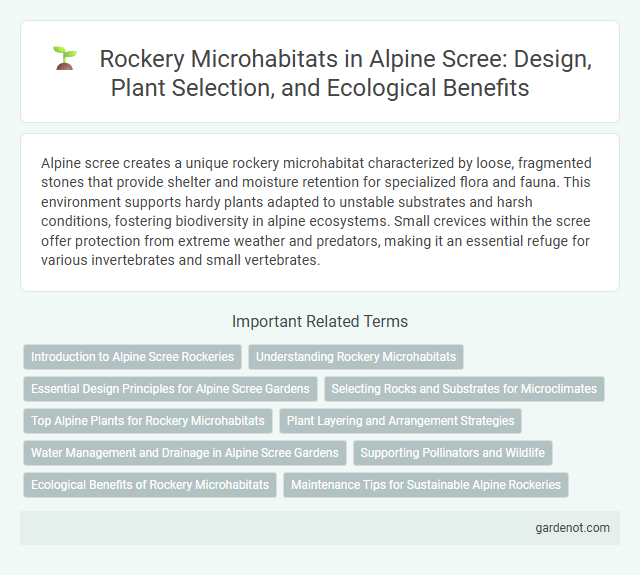Alpine scree creates a unique rockery microhabitat characterized by loose, fragmented stones that provide shelter and moisture retention for specialized flora and fauna. This environment supports hardy plants adapted to unstable substrates and harsh conditions, fostering biodiversity in alpine ecosystems. Small crevices within the scree offer protection from extreme weather and predators, making it an essential refuge for various invertebrates and small vertebrates.
Introduction to Alpine Scree Rockeries
Alpine scree rockeries consist of loose, fragmented rock debris that accumulates on steep mountain slopes, forming a unique microhabitat characterized by extreme temperature fluctuations and limited soil development. These scree environments provide specialized niches for drought-resistant and cold-tolerant flora, including cushion plants, lichens, and mosses, which stabilize the substrate and contribute to nutrient cycling. The structural complexity of alpine screes supports diverse invertebrate populations and offers shelter for small mammals and ground-nesting birds, making it a critical component of high-altitude biodiversity.
Understanding Rockery Microhabitats
Rockery microhabitats in alpine scree provide crucial refuge characterized by loose, angular rocks that create diverse thermal and moisture gradients supporting specialized flora and fauna. These microhabitats offer shelter from harsh winds and temperature extremes while facilitating soil development in crevices, promoting plant colonization and biodiversity. Understanding the spatial arrangement and physical properties of rockery microhabitats is essential for assessing ecological resilience and species adaptation in alpine environments.
Essential Design Principles for Alpine Scree Gardens
Rockery microhabitats in alpine scree gardens rely on key design principles such as selecting well-draining, gritty soils mixed with coarse sand and gravel to mimic natural scree conditions. Incorporating angular rocks and stones arranged in uneven, layered formations supports root anchorage and simulates natural alpine erosion processes. Ensuring exposure to full sun and protection from excessive moisture replicates harsh alpine climate factors essential for the thriving of scree-adapted plant species like Saxifraga and Androsace.
Selecting Rocks and Substrates for Microclimates
Selecting rocks for an alpine scree rockery microhabitat involves prioritizing porous, heat-retentive substrates like sandstone or limestone to create varied microclimates. Arranging stones of different sizes and orientations supports moisture retention and temperature fluctuations vital for alpine flora and fauna. Ensuring proper drainage with gravel or coarse sand underneath enhances root aeration and prevents waterlogging in these specialized habitats.
Top Alpine Plants for Rockery Microhabitats
Alpine scree rockery microhabitats support specialized top alpine plants such as Saxifraga oppositifolia, Silene acaulis, and Androsace alpina, which thrive in well-drained, rocky substrates with sparse soil. These plants exhibit adaptations like cushion growth forms and deep root systems to withstand extreme temperature fluctuations and nutrient-poor conditions. The diversity of flora in scree environments contributes to ecosystem stability and provides critical niches for alpine pollinators.
Plant Layering and Arrangement Strategies
Alpine scree rockery microhabitats exhibit distinct plant layering strategies that maximize survival under harsh environmental conditions. Vegetation often forms tightly packed mats and cushion plants at the ground level, reducing exposure to wind and conserving moisture, while sparse taller, woody shrubs provide structural support and trap soil particles. This spatial arrangement optimizes resource use, enhances microclimate stability, and facilitates nutrient cycling within the alpine scree ecosystem.
Water Management and Drainage in Alpine Scree Gardens
Rockery microhabitats in alpine scree gardens require precise water management to mimic natural drainage patterns and prevent waterlogging. Porous substrates and inclined layering facilitate rapid runoff while retaining necessary moisture for alpine vegetation. Effective drainage systems reduce root rot risk and support the survival of drought-tolerant plants endemic to high-altitude scree environments.
Supporting Pollinators and Wildlife
Rockery microhabitats in alpine scree provide essential shelter and foraging resources for pollinators such as bees, butterflies, and hoverflies, supporting biodiversity in harsh mountainous environments. These microhabitats offer a variety of flowering plants that bloom sequentially, ensuring a continuous nectar supply throughout the growing season. The crevices and soil pockets within rockeries also serve as nesting and overwintering sites for many insect species, facilitating their survival and ecological function.
Ecological Benefits of Rockery Microhabitats
Rockery microhabitats in alpine scree provide critical shelter and nesting sites for specialized flora and fauna, enhancing biodiversity in harsh mountainous environments. These microhabitats retain moisture and moderate temperature fluctuations, supporting endemic plant species adapted to extreme conditions. The structural complexity of rockery zones promotes soil stabilization and nutrient cycling, crucial for sustaining ecological balance in alpine ecosystems.
Maintenance Tips for Sustainable Alpine Rockeries
Alpine rockeries require well-drained soil and regular removal of debris to maintain the microhabitat's stability and plant health. Incorporate native alpine plants with shallow root systems to prevent erosion and support local biodiversity. Seasonal monitoring for pests and adjusting irrigation during dry periods ensures a sustainable and thriving rockery ecosystem.
Rockery microhabitat Infographic

 gardenot.com
gardenot.com